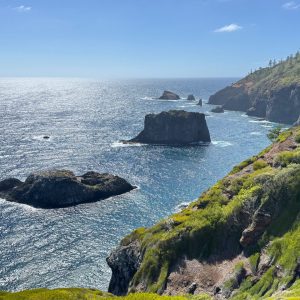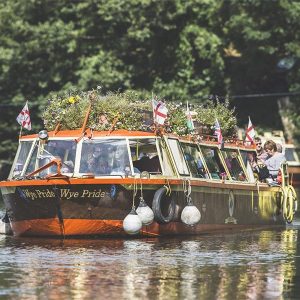En route to Cordoba we heard about some of Spain’s more recent history. During the Civil War of 1936-1939, 600,000 people died and 1 million emigrated from the country. General Franco’s totalitarian rule only really ended with his death in 1975, and is now known as The National Tragedy.
In Cordoba, the beautiful ‘El Puente Romano’ spans the Guadalquivir river, and is testament to the city’s strategic importance for the Romans. But most people come here to visit the dazzling Mezquita. 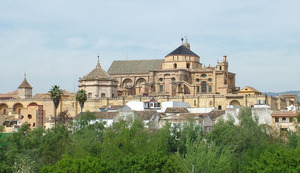 On a guided tour inside its striking walls, you’ll learn that the original vast mosque was completed in the 10th century, was enlarged several times so that only Mecca has a larger mosque anywhere in the world, and was overlaid with a Renaissance-style Christian cathedral in the early 16th century. Words cannot adequately capture the scale and beauty of this edifice that so perfectly represents the layers of religion and history in the region.
On a guided tour inside its striking walls, you’ll learn that the original vast mosque was completed in the 10th century, was enlarged several times so that only Mecca has a larger mosque anywhere in the world, and was overlaid with a Renaissance-style Christian cathedral in the early 16th century. Words cannot adequately capture the scale and beauty of this edifice that so perfectly represents the layers of religion and history in the region.
There will also be time to explore the labyrinthine medieval cobbled streets, once the Jewish quarter and now an entrancing combination of shops, restaurants, churches, squares and homes with concealed courtyards. Be warned – it’s very easy to get lost!
One of the many attractions of this tour is the painless way in which you’re transferred between the main destinations. Travelling in a luxury coach, our excellent Tour Director Ann ensured we were always fully informed about logistics and practical information. And along the way she also gave us some useful historical context, and an insight into Spanish and Andalucian culture, but all in an unobtrusive, gently humorous way.
En route to Granada, we were given a short comfort break at a converted railway station in Luque. This attractive village is in the heart of olive tree country, so it would have been rude not to buy some of their amazing ‘crema de manos y unas de aceite de oliva virgen extra’ at the station cafe and shop. And then cup a cafe con leche or a cerveza in your smooth, sweet-smelling hands.
Granada 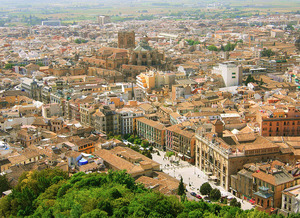 is arguably the most beguiling city in Spain, and a fitting end to your tour of Andalucia.
is arguably the most beguiling city in Spain, and a fitting end to your tour of Andalucia.
Ringed by the Sierra Nevada mountain range, it is best known for the Alhambra, a Moorish fortress and palace that watches over Granada like a solicitous parent. But more of that later.
On arrival, relax in your comfortable hotel in the newer part of town. Stay low to explore the Plaza de Toros area, or the dancing fountains of the Jardines del Triunfo, a contemporary geometrically designed garden, or just people watch in the busy Plaza Nueva. Or go higher, to the Albaicin district of the city. Walk up the steep, cobbled streets – or jump in a cheap taxi – to see this UNESCO World Heritage site.
With its history rooted in medieval Moorish times, you’ll find narrow, winding streets, delightful small squares, charming houses with geranium-strewn balconies, and a host of tiny churches, most built on the site of old Mosques. But you’ll probably eventually be drawn – like a moth to a flame – to the Mirador de San Nicolas. If you can see past the camera-toting throng, this plateau offers picture-perfect, panoramic views of the Alhambra, across the dividing gorge and with the river Darro way below.
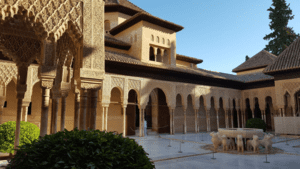 The following day, you’ll finally get up close and personal with the Alhambra, on an expertly guided tour of this unforgettable fortress palace. Originally built as a small fortress in the 9th century, on the site of old Roman fortifications, it wasn’t until the 13th and 14th centuries that the Moors enlarged it into a royal palace. The final Arabic regime – the Nasrid dynasty – introduced most of the beautiful architecture and decorations that remain today. Or at least what has been restored for us to see now.
The following day, you’ll finally get up close and personal with the Alhambra, on an expertly guided tour of this unforgettable fortress palace. Originally built as a small fortress in the 9th century, on the site of old Roman fortifications, it wasn’t until the 13th and 14th centuries that the Moors enlarged it into a royal palace. The final Arabic regime – the Nasrid dynasty – introduced most of the beautiful architecture and decorations that remain today. Or at least what has been restored for us to see now.
King Ferdinand and Queen Isabella occupied the Palace after the reconquest of 1492. The separate, huge Palace of Emperor Charles V, a perfect example of Spanish Renaissance architecture, was commenced during his reign, before the entire Alhambra fell into a state of near ruin in the 18th and 19th centuries, occupied by vagabonds and thieves.
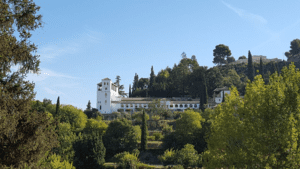 Fortunately, the Alhambra is now restored to its former glory. On the tour, you’ll see the Nasrid palaces with the Court of Lions, the Alcazaba, the harem and much more. And as a bonus, you’ll also be taken to the Generalife, the summer palace – or perhaps the hunting lodge – for the Sultans, a place where they could escape from the pressure and intrigue of the Alhambra. Architecturally it has no real significance, but the gardens and the location are what demand a sharp intake of tourist breath.
Fortunately, the Alhambra is now restored to its former glory. On the tour, you’ll see the Nasrid palaces with the Court of Lions, the Alcazaba, the harem and much more. And as a bonus, you’ll also be taken to the Generalife, the summer palace – or perhaps the hunting lodge – for the Sultans, a place where they could escape from the pressure and intrigue of the Alhambra. Architecturally it has no real significance, but the gardens and the location are what demand a sharp intake of tourist breath.
Your circular tour of Andalucia is nearly over. But first, take an optional afternoon tour to see Granada’s impressive Cathedral, the Catholic Royal Chapel – final resting place of Ferdinand and Isabella – and more.
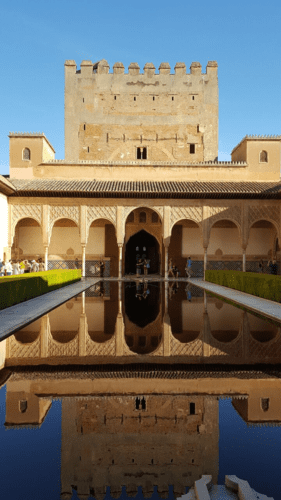 Or if you’re exhausted from all that history and sightseeing, immerse yourself instead in a traditional Arab experience and spend a couple of hours at the Hammam Al Andalus. Built on the ruins of an old hammam from the 13th century, this is a faithful recreation of an original Muslim tradition. With Andalucian music playing gently in the background, move between the thermal contrasts to reinvigorate those tired muscles and minds – from absolute relaxation in the hot pool or steam room, to stimulation in the cold pool, and gentle comfort in the warm pool. Traditionally the largest, this is where bathers would linger longest, to discuss politics, business or religion.
Or if you’re exhausted from all that history and sightseeing, immerse yourself instead in a traditional Arab experience and spend a couple of hours at the Hammam Al Andalus. Built on the ruins of an old hammam from the 13th century, this is a faithful recreation of an original Muslim tradition. With Andalucian music playing gently in the background, move between the thermal contrasts to reinvigorate those tired muscles and minds – from absolute relaxation in the hot pool or steam room, to stimulation in the cold pool, and gentle comfort in the warm pool. Traditionally the largest, this is where bathers would linger longest, to discuss politics, business or religion.
Sip sweet tea from ornate teapots, before being summoned for your massage. Choose an oil scented with rose, lavender, red amber or pomegranate flower, and imagine you’re back in the middle ages. Granada is the Spanish word for pomegranate, so my decision was an easy one.
The hammam has superb mosaics and decorative inlays that are redolent of the Alhambra itself. Let your imagination drift back a few centuries and imagine you’re a Sultan, rather than a 21st century tourist about to leave exotic Andalucia.
Gill and I normally prefer independent travel to an organised group tour. But this one from Cosmos was a revelation, and a hugely rewarding travel experience. We learnt so much from the three included guided tours by local experts, and also from the commentary by Tour Director Ann. The optional tours – particularly the flamenco night in Seville – were great fun. There was plenty of spare time along the way, to either relax at the comfortable 4* hotels in each city, explore more or find alternative activities, as we did. The horse riding and hammam were enjoyable contrasts to sightseeing and history!
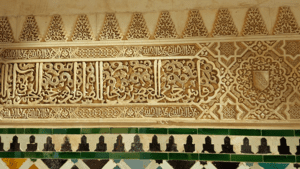 And it was good to get to know our fellow travellers along the way, either over the generous buffet breakfasts at each hotel, in the comfortable coaches or over some tapas in a local restaurant.
And it was good to get to know our fellow travellers along the way, either over the generous buffet breakfasts at each hotel, in the comfortable coaches or over some tapas in a local restaurant.
This really is a perfectly structured trip, offering a great balance between the ancient and the contemporary, exploration and leisure, structure and flexibility, education and sheer enjoyment. And it all unfolds in a unique landscape of bewitching contrasts through history.
To paraphrase The Life Of Brian: ”what did the Moors ever do for us?” Well, quite a lot actually, as you’ll see on this time travelling tour of alluring Andalucia, that should appeal to most Silver Travellers.
Silver Travel Advisor recommends Cosmos Tours and Cruises.
Discover Andalucia with Cosmos Tours – Part 1

